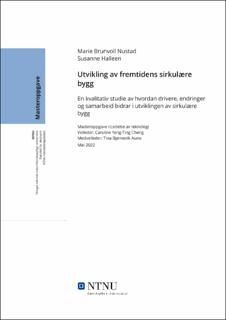| dc.contributor.advisor | Cheng, Yeng-Ting Caroline | |
| dc.contributor.advisor | Aune, Bjørnevik Tina | |
| dc.contributor.author | Nustad, Brunvoll Marie | |
| dc.contributor.author | Halleen, Susanne | |
| dc.date.accessioned | 2022-09-20T17:22:52Z | |
| dc.date.available | 2022-09-20T17:22:52Z | |
| dc.date.issued | 2022 | |
| dc.identifier | no.ntnu:inspera:112633268:114421190 | |
| dc.identifier.uri | https://hdl.handle.net/11250/3019965 | |
| dc.description.abstract | Bakgrunnen for studiet er at byggebransjen står for et høyt klimagassutslipp og det er derfor behov for å utvikle bærekraftige løsninger der sirkulære bygg er et av tiltakene.
Studiets formål er:
Hvordan kan drivere, endringer og samarbeid i byggebransjen bidra i utviklingen av sirkulære bygg?
Problemstillingen besvares gjennom følgende tre forskningsspørsmål:
1. Hvilke barrierer og drivere eksisterer i overgangen til en sirkulær byggebransje?
2. Hvordan kan aktørene endres, og hvilke nye roller kan oppstå ved utviklingen av
sirkulær bygg?
3. Hvordan kan samarbeid mellom aktørene bidra i utvikling av sirkulære bygg?
Forskningsspørsmålene belyses med utgangspunkt i teori og resultater. Oppgavens resultater tar utgangspunkt i intervju med aktører som jobber med sirkulære byggeprosjekt innenfor den norske byggebransjen. Teorien er knyttet til sirkulær økonomi, drivere og barrierer for sirkulær økonomi i byggebransjen, samt litteratur knyttet til nettverk, relasjoner og samarbeid i verdikjeden.
Studiet identifiserer at dersom byggebransjen skal klare å bygge sirkulære bygg, er bransjen avhengig av å overkomme flere barrierer for en vellykket implementering. Dette er barrierer i hovedsak knyttet til mangel på kunnskap og kompetanse, samt mangel på regelverk og insentiver for gjenbruk. Videre viser funn fra oppgaven at sentrale aktører trolig vil få en endret rolle i utviklingen av sirkulære bygg. Forskerne identifiserer at arkitekt og leverandør av byggematerialer vil få endret sin rolle ved design for demontering, og produksjon av materialer som skal benyttes for gjenbruk. Sirkulære bygg må designes på en måte som gjør at byggene kan demonteres på en effektiv måte. I tillegg åpner sirkulære bygg opp for nye muligheter for leverandør som må produsere materialer som kan demonteres, og dermed kan utvide sin rolle i verdikjeden ved å ta tilbake materialet fra et bygg og bruke det på nytt i et annet bygg. Studien viser videre at bransjen består av et komplekst bedriftsnettverk med mange ulike aktører som påvirker hverandre. Samarbeid mellom aktørene i verdikjeden skaper dermed en arena for utvikling og testing av nye løsninger der aktørene er avhengig av hverandre for å implementere sirkulære tiltak. | |
| dc.description.abstract | The construction industry accounts for high CO2 emissions and consumption of raw material. There is a need to reduce greenhouse emissions and therefore develop sustainable solutions where circular buildings are one of the measures. To understand how the industry can change towards building circular buildings, it is necessary to look at the barriers for implementing circular measures and how the actors can contribute. The purpose of the study is to identify how drivers, changes and collaboration in the construction industry contribute to the development of circular buildings. The problem statement is answered through three research questions: 1) What barriers and drivers exist in the transition to a circular economy? 2) How can the actors change, and what new roles can arise in the development of circular buildings? 3) How can cooperation between the actors contribute to the development of circular buildings?
The thesis is based on theory and data collection from a qualitative research method. The data collection is based on semi-structured interviews with central actors who work with a circular building project in the Norwegian construction industry. The theory of the thesis is related to circular economy, drivers and barriers to circular economy in the construction industry, as well as literature related to network, relationships and corporation in the value chain.
The study identifies that the construction industry is dependent on overcoming several barriers for a successful implementation. These are barriers mainly related to a lack of knowledge and competence, as well as a lack of regulations and incentives for reuse. Furthermore, the study shows that the industry consists of a complex imbedded network with many different actors influencing each other. The researchers identify that the architect and supplier of building materials will have their role changed in the design for deconstruction, and the production of materials that can be reused. Circular buildings must be designed in a way that they can be deconstructed in an efficient manner. In addition, circular buildings open new opportunities for suppliers who must produce materials that can be deconstructed, and they can expand their role in the value chain by taking the material back from one building and use it again in another. Further findings show that cooperation between the actors in the value chain creates a space for development and testing of new circular solutions where the actors are dependent on each other to find new solutions and implement it in the value chain. | |
| dc.language | nob | |
| dc.publisher | NTNU | |
| dc.title | Utvikling av fremtidens sirkulære bygg | |
| dc.type | Master thesis | |
